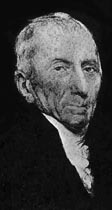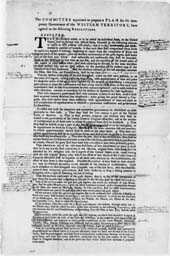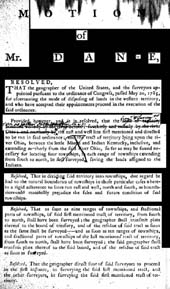 |
| Collaboration home |
 |
| Figure 1: United States Congress, March 1, 1784, Printed Resolution on Western Territory Government; with Notations by Thomas Jefferson (Library of Congress) |

Nathan Dane and the Ordinance of 1787
By
Patrick Murray
Submitted
to Mr. Eastman
Department of History
Beverly,
Massachusetts
23 January
2002
Nathan Dane was born in Ipswich, Massachusetts, on December 27 1752. He spent most of his leisure time reading and studying mathematics. Dane wanted to go to college, so he privately prepared himself for eight months before entering Harvard College in 1774. Once Dane graduated in 1778 he read law in the office of Judge William Wetmore of Salem and at the same time he was teaching at a school in Beverly, Massachusetts. After studying law Dane was admitted to its practice and he settled in Beverly.
In 1782 Nathan Dane began the practice of law in Beverly, which quickly turned into a profitable business. After practicing law for about twenty years Dane retired due to his growing deafness. In the years of 1782-1785, he was a representative in the General Court of Massachusetts and a member of the Massachusetts legislature. In 1785 he was a delegate to the Continental Congress where he stayed by re-election until 1788.
A lot of people had their influence in the Ordinance of 1787. Nathan Dane was the framer, compiler, and writer of the celebrated Ordinance passed by Congress on July 13, 1787 for the government of the territory northwest of the Ohio River. He got most of its matter from previously failed ordinances and the Massachusetts Laws he knew so well. The Northwest Ordinance of 1787 was adopted without a single alteration.
On January 2, 1778, Governor Patrick Henry of Virginia wrote to Colonel George Rogers Clark to instruct him in a mission to Kentucky and the lands north and west of the Ohio River. By carrying out this mission, Clark and his men kept the British from taking over Kentucky during the War of Independence and enabled the United States to claim the land north and west of the Ohio River at the end of the war (see Clark's Letter of Instruction, 1778). The United States acquired the land on September 3, 1783 when Great Britain signed the Treaty of Paris, ending the War of Independence and establishing the boundaries of the new nation. On March 1, 1781 all thirteen states ratified the Articles of Confederation, which was an agreement under which the thirteen original states establish a Federal Government, the first constitution of the new country. The Articles of Confederation served as the new nation's basic charter of government until the first government under the Constitution of the United States was formed in 1789.[1]
The Northwest Ordinance was the most significant achievement of Congress under the Articles of Confederation.
States tried claiming land in the new territory, but on March 1, 1784, Congress accepted the Virginia Act of Cession, ending all the states' claims to the land. Then on April 23, 1784, Congress approved the Ordinance of 1784 (see Figure 1), a plan proposed by Thomas Jefferson. It set up a temporary government for the territories, provided that the region is divided up into numerous territories, and its anti-slavery provision he advocated was defeated by a vote of seven states to six. The Ordinance of 1784 never went into effect. On May 20, 1785 Congress passed the Land Ordinance of 1785, which was a plan for dividing and selling the land north and west of the Ohio River. The ordinance called for the land to be surveyed and divided into townships. Each township would be 6 miles square. Each township would have 36 sections. A section was one square mile and contains 640 acres. Congress planned to sell sections to settlers for $640 each. Also, one section in every township was to be set aside to support public schools (see Figure 2).
The Ohio Company Associates organized in Massachusetts and composed of Massachusetts’s men, put in an application to buy a large tract of land in the region. The interests of the Ohio Company in colonizing the Ohio country led Congress to enact an ultimate plan for the government of the territory. The leaders of the Company, Manasseh Cutler and Rufus Putnam were influential in the drafting of the Ordinance of 1787. Once the Ordinance of 1787 was established, the Ohio Company Associates were the first settlers to colonize the Northwest Territory by walking from Ipswich Massachusetts all the way to Marietta Ohio.
On May 9, 1786, a committee of Congress, headed by James Monroe of Virginia, made a report about a plan for governance of the Northwest Territory that would be the basis for the final Ordinance. Monroe’s Committee was reorganized on September 18, 1786 when a new congressional committee, consisting of Nathan Dane of Massachusetts, William Samuel Johnson of Connecticut, Charles Pickney of South Carolina, Melancton Smith of New York, and William Henry of Maryland reported an elaborated system for the temporary government of the west, but it failed to gain final approval of Congress. Subsequently Congress appointed Virginians Edward Carington and Richard Henry Lee, and South Carolinian John Kean to join Dane and Smith. They quickly produced a new draft in a week.
On July 13, 1787, the Continental Congress, then meeting in New York, enacted "An Ordinance for the government of the territory of the United States north west of the Ohio River" (see Ordinance of 1787). During the time the ordinance was drafted the only inhabitants in the area were about 3000 Louisianans, French Canadians and roving Indians.[2] There were some British troops still posted in parts of the Northwest Territory years after the war ended. The ordinance acted as an attraction for people to leave their homes in the settled east and cross the mountains into the wilderness and settle down in the new western lands. The ordinance provided that the navigable waters leading into the Mississippi and Saint Lawrence, and the carrying places between the same, shall be common highways and forever free to the inhabitants of the said territory and the citizens of the United States. This was an attraction for Businesses to expand westward. If properly developed, the incredibly rich western lands offered unprecedented opportunities for enterprising settlers.
The Ordinance of 1787 guaranteed that the territory would be broken up into no less than three and no more than five states. Under the terms of the ordinance, the territories could enter the Union on an equal footing with the original states by passing through three steps leading to full self-government. First the Congress which governed the territory, appointed a governor, a secretary, and three judges. Then when the territory, or any division of it, attained an adult male population of 5,000, it could choose a legislature and send to Congress a delegate who could speak there but not vote. Finally when the total population reached 60,000, the territory could apply for admission into the Union on terms of full equality with the older states. The ordinance removed the danger of colonial rebellion because it assured the territories participation in the National Government. It became a model for all territories that later entered the Union as states. Ohio was the first state formed, and entered the Union in 1803; Indiana became a state in 1816, Illinois in 1818, Michigan in 1837, and Wisconsin in 1848. Once a wilderness is now covered by five great states teeming with more than ten million people, one forth of the population of the United States.[3] Exactly 31 states achieved statehood and entered the Union under the provisions of the Ordinance of 1787.
Some attractions to those states that had feudal laws, the Northwest Ordinance prohibited the feudal law of primogeniture, and provided that the property of a dying parent estate should be divided equally among their children, or next of kin.[4] It states that no person demeaning himself in a peaceable and orderly manner shall ever be molested on account of his mode of worship or religious sentiments. It declared that religion, morality, and knowledge being necessary to good government, and the happiness of mankind, schools and means of education should always be encouraged. The ordinance says that the revenue generated from the sale of a portion of each township in the state would go to fund public education. This was the first instance of federal aid for education in American history.
The inhabitants of the Northwest Territory shall always be entitled to the writings of habeus corpus, of trial by jury, of a proportional representation in the legislature and jurical proceedings, according to the course of the Common Law.[5] All persons shall be bailable, unless for capital offences when the proof shall be evident, or the presumption great. It states that all fines should be moderate, and no cruel and unusual punishment shall be inflicted. No man shall be deprived of his liberty or property, but by the judgment of his peers, or the laws of the land. A good faith effort was made to respect the Indians in the Territory.
If the public finds it necessary to take any man’s property, or to demand his particular services, full compensation shall be made for the same. In the just preservation of rights and property, it is understood and declared that no law ought ever to be made or have force in the said territory that shall in any manner whatever interfere with or affect private contracts or engagements "bona fide" and without fraud previously made. It was the first embodiment in written Constitutional Law of a provision maintaining the obligation of contracts.
It forever prohibited slavery and involuntary Servitude. No one born in the Northwest Territory should be a slave, and no law should ever be passed to change that. By federal mandate, each of the in the Northwest Territory entered the Union slave free, a fact that would weigh heavily against the institution of slavery for years. If the slavery prohibition had not been an "Article of Compact" Indiana, Illinois, and possibly Ohio would have been admitted to the Union as Slave States. By this last provision, the celebrated Article six, the Ohio River became the historic boundary between free soil and slave. It determined what sort of country this was going to be; the concept of complete equality. A precious part of the world’s heritage in distant ages to come.
Now there has been a lot of controversy surrounding Nathan Dane as the author of the Ordinance of 1787 and the non-slavery clause, but that is false. Mr. Dane doubtless wrote the draft with his legalistic style, but the ordinance and especially the non-slavery clause was not the work of Nathan Dane of Massachusetts, but of Thomas Jefferson of Virginia. In Nathan Danes letter on May 12, 1831 to the Indiana Historical Society he says, "It will be observed that the provisions four, five, and six some now view as oppressive to the west, were taken from Mr. Jefferson’s Plan of 1784." Massachusetts delegate Nathan Dane proposed Article Six just before the final text of the document was adopted. Dane confessed that he had no idea that the states would agree to the "Slavery Prohibition".
Mr. Dane wrote the draft and performed the clerical duties of the committee. Nathan Dane was the author of the Ordinance in a higher sense of furnishing its fundamental ideas, the occasion, the personal influence, and the strategy. He was a dictator of the committee’s ideas, a shorthand writer (amanuenses). Thomas Jefferson, James Monroe, Manasseh Cutler, Rufus Putnam all had a massive influence on Dane. He was the compiler of the final Ordinance. He molded together the three previous ordinances. Mr. Dane was the only member of the committee familiar with the Massachusetts Constitution, and the Ordinance of 1787 was framed mainly from the laws of the Massachusetts Constitution. In a letter from Mr. Dane to Rufus King dated July 16 1787, he states that he drew the ordinance, with an air of triumph.[6] A letter from Dane to Rufus King on July 16 1787 and Dane to Mr. Daniel Webster on March 26 1830, and the Massachusetts Historical Societies proceedings 1867-1869 page 470 J. H. Farnham on May 12 1831. In all three cases Dane Claims to be the Author of the Ordinance of 1787.[7]
The Ordinance of 1787 was obscure, conflicting, and has erroneous statements. Dane claims, owning to the obscurity of his style, difficult to understand.[8]
Why has the Northwest ordinance suffered so much neglect? It’s incredibly complex, unappealing, and legalistic style in which it was written. Congress considered it for more than three years; it was modified extensively and completed in a single week, from the sixth to the thirteenth of July 1787. The ordinance was created by a succession of committee’s, it’s principal figures were Nathan Dane and Rufus King, neither of them had a penchant for lofty political philosophy. It was a product of a dying Congress not able to function under the ineffective and tormented Articles of Confederation. The principal reason for it’s passage in 1787 was the near bankruptcy of the federal treasury and the availability of ready cash from speculative land companies ready to take chunks of public domain for pennies on the acre once government in the territories had been established. It was to make a profit because of the dying Congress and conniving speculators especially the Ohio Company Associates. It compelled men to look past their own dooryards to something unlimited beyond the horizon, and decreed that a man’s place as a member of the American Republic would be forever greater than his place as a resident of a single state.[9]
In his famous exchange with Senator Robert Hayne of South Carolina in 1830, Massachusetts Daniel Webster celebrated Danes key contributions as author of the Ordinance in guaranteeing freedom in the old northwest. Webster doubted "whether one single law of any law giver, ancient or modern, has produced effects of more distinct, marked, and lasting character, than the Ordinance of 1787". Throughout the 1830’s, many northwesterners exalted Dane as "the venerable author of the ordinance of 1787". In 1833, the "Natives of Ohio" toasted his "political wisdom" for securing "The blessing of religion, and learning, and freedom; his name will be hallowed forever". At the Settlement Anniversary Celebration, the Ordinance was toasted: "May its principals be firmly implanted in our affections, and the remembrance of its author (the Venerated Dane) indelibly engraved in the hearts of our children". Dane himself formed it and furnished most of its matter. Nonetheless tributes to Dane are revealing. A northwestern publicist needed a founding father to give mythic resonance to their histories. Therefore, just as the authors of the Federal Constitution were considered the Nation's Founders, Dane, author of the Ordinance, was portrayed as founder of the old northwest.[10]
In 1789 the Constitution of the United States was adopted as a binding force with the Ordinance of 1787, adapting its provisions to the Federal Constitution. The Ordinance of 1787 is perhaps the most notable instance of legislation that was ever enacted by the representatives of the American people. It fixed forever the character of the immigration, and the social, political, and educational institutions of this territory. Embodied in six articles, it is intended to forever remain unalterable unless by common consent.[11]
The Northwest Ordinance is one of the most important documents of the American founding period and perhaps ever, in it's guarantees of freedom and civil liberty.[12] Three of the most Fundamental documents to the formation of the Nation were the Declaration of Independence, the Constitution, and the Northwest Ordinance: "Our Trinity of Revolutionary Testaments".[13] During our Civil War from 1861 to 1865 every square mile that the Ordinance of 1787 covered was patriotic and gave the Unions men the support they needed to win the war.[14] It was the most high-minded colonial policy the world has ever seen.[15] It embodies a vision of a more harmonious, powerful, prosperous, and expanding Union. The Ordinance of 1787 had no old rubbish to clear away, no deep-seated customs and prejudices to contend against. It stamped itself upon the soil while it was yet a wilderness, and it’s impress can be seen today in the laws, the character, the social habits, and thrift of these great northwestern states.[16]
References
Shriver, Phillip R. "The Northwest Ordinance: America’s Other Bicentennial" A Bicentennial Chronicle, Spring 1987, No. 14. Appeared originally in The Old Northwest: A Journal of Regional Life and Letters, Volume 9, No. 3 Fall 1983.
Onuf, Peter S. Statehood and Union: A History of the Northwest Ordinance. Indiana University Press: Bloomington and Indianapolis,1987. L.
Saltonstall. The Constitutions of the United States, according to the latest amendments: to which are prefixed, the Declaration of Independence; and the Federal Constitution, with the amendments. Philadelphia, 1800
United States. Continental Congress. "An Ordinance for the Government of the Territory of the United States, Northwest of the River Ohio Philadelphia" Printed by John Dunlop 1787. A version of the Ordinance. Available at the Massachusetts Historical Society on Microfiche (Early American Imprints. First series; no. 45181).
Rakove, Jack N. "Articles of Confederation," World Book Online Americas Edition, Available at: http://www.aolsvc.worldbook.aol.com/wbol/wbPage/na/ar/co/032320 December 20, 2001.
"Articles of Confederation" http://www.usconstitution.net/articles.html January 28, 2002.
Poole, William F. "The Ordinance of 1787: a reply," Anne Arbor, Michigan, private print. The Inlander (January 1892). A reply to an article by Henry A Chaney in The Inlander in November 1891. Printed Material Available at the Massachusetts Historical Society. In Volume Back Titled: Ordinance of 1787, Poole. E178
Poole, William F. The Ordinance of 1787 and Dr. Manasseh Cutler as an Agent in its Formation. Anne Arbor, Michigan, private print. 1892. Printed Material Available at the Massachusetts Historical Society. In Volume Back Titled: Ordinance of 1787—Poole. E178
Jensen, Merrill. The Articles of Confederation : An interpretation of the social-constitutional history of the American Revolution 1774-1781. The University Press of Wisconsin, Madison Wisconsin 1940
"General Correspondence 1651-1827," Thomas Jefferson Paper Series 1. United States Congress, March 1 1784. Printed resolution on Western Territory Government, with notations by Thomas Jefferson.
"Thomas Jefferson Timeline, the Early Republic 1784-1789". Thomas Jefferson Paper Series 1. Available at http://memory.loc.gov/ammem/mtjhtml/mtjtime3a.html January 23, 2002
"The Northwest Ordinance Timeline 1784." Time table of events regarding the Northwest Ordinance of 1787. Congress approved the territorial Ordinance of 1787, written by Thomas Jefferson, to serve as a plan for temporary government of the Western Territories. Available at http://www.statelib.in.us/WWW/ihb/tlnword.html
"George Rogers Clark’s Letter of Instruction 1778." Governor Patrick Henry of Virginia wrote to Colonel George Rogers Clark to instruct him in a mission to Kentucky and the lands north and west of the Ohio River. Available at: http://www.statelib.lib.in.us/WWW/ihb/henryltr.html
Text of the Declaration of Independence (July 4, 1776) celebrated by the 4th of July public holiday in the US.
Available at: http://www.law.indiana.edu/uslawdocs/declaration.html
[1]Rakove, Jack N. "Articles of Confederation," World Book Online Americas Edition, http://www.aolsvc.worldbook.aol.com
[2] Poole, William F. “the Ordinance of 1787 and Dr. Manasseh Cutler as an agent in its formation."
[3] Poole, William F. “the Ordinance of 1787:a Reply”
[4] The system of inheritance or succession by the firstborn, specifically the eldest son
[5] Habeas Corpus, which literally means "you have the body," is one of the fundamental rights in Anglo-America law. Through the writ of habeas corpus, a prisoner may challenge the legality of his or her imprisonment, and if the state cannot present adequate evidence to justify the jailing, the court may order the prisoner's release.
[6] Poole, William F. “the Ordinance of 1787 and Dr. Manasseh Cutler as an agent in its formation."
[7] Poole, William F. “the Ordinance of 1787:a Reply”
[8] “General Abridgement and Digest of American Law, volume 9, note A" published in 1830.
[9] Shriver, Phillip R. “the Northwest Ordinance: America’s Other Bicentennial”
[10] Poole, William F. “the Ordinance of 1787:a Reply”
[11] Poole, William F. “the Ordinance of 1787:a Reply”
[12] Poole, William F. “the Ordinance of 1787:a Reply”
[13] Shriver, Phillip R. “the Northwest Ordinance: America’s Other Bicentennial”
[14] Poole, William F. “the Ordinance of 1787 and Dr. Manasseh Cutler as an agent in its formation.
[15] Shriver, Phillip R. “the Northwest Ordinance: America’s Other Bicentennial”
[16] Poole, William F. “the Ordinance of 1787 and Dr. Manasseh Cutler as an agent in its formation.

"I want to give special thanks to the Massachusetts Historical Society and the Beverly Historical Society for all the contribution they made to my paper, and all the extra help they gave my class." -PJ Murray
Please send comments to pjmurray19@aol.com
 |
| Figure 2 : "Motion of Mr. Dane" (Broadside) (Massachusetts Historical Society) |
This page was last updated February 3, 2002. © 2002 Primary Research .org. Please send comments to comments@primaryresearch.org